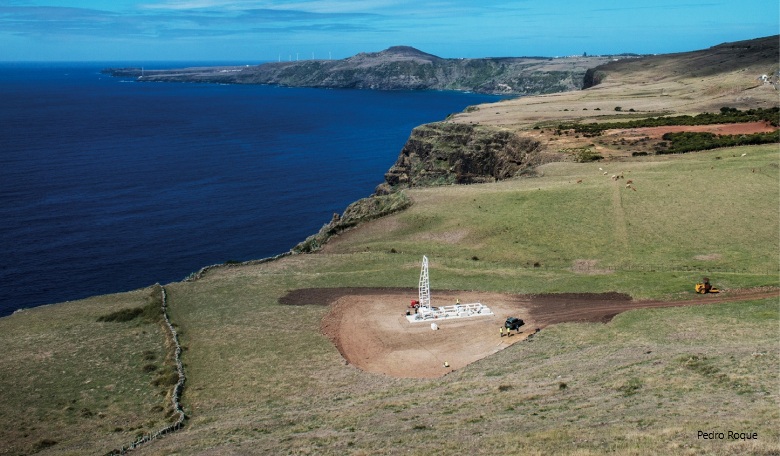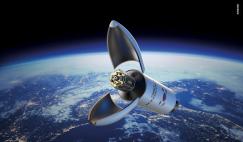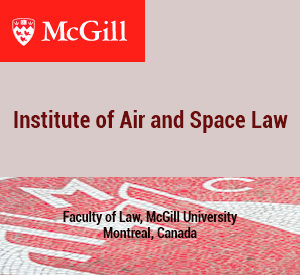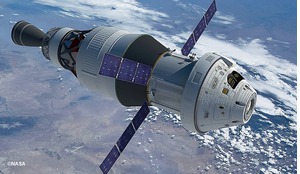In a milestone achievement for Portugal’s growing space ambitions, the Atlantic Spaceport Consortium carried out successful back-to-back launches of suborbital rockets from Santa Maria Island in the Azores last autumn. The proof-of-concept event underscored the country’s determination to establish a commercially open spaceport capable of supporting suborbital and, later, orbital launches. With its strategically advantageous location and a quickly maturing regulatory framework, the Azores spaceport initiative is gaining attention from across the space industry. In this article, Editor-in-Chief Clive Simpson delves into the Atlantic Spaceport Consortium’s vision, explores Portugal’s broader space aspirations and describes how an Azores spaceport might fill a gap in Europe’s medium launcher capacity.
When the first rocket roared into the skies above the Azores on a sunny day at the end of September, a new chapter in Portugal’s space history was written. The launch vehicle - called GAMA and developed and promoted by the Atlantic Spaceport Consortium (ASC) - blasted off from the Malbusca site on Santa Maria Island, reaching a top speed of 400 m/s and soaring to an altitude of 5,596 metres. Though modest in comparison to larger commercial or scientific rockets (3.35 m high with a take-off weight of 23 kg), it was still enough to claim a domestic record for Portuguese-built launch vehicles.
The significance of this milestone goes well beyond the numbers. As a private initiative, it sends a clear message about Portugal’s emerging capability within the evolving global NewSpace industry. It also highlights a future business proposition: a commercial spaceport capable of handling regular launch schedules and supporting a wide array of space activities, all from the mid-Atlantic.
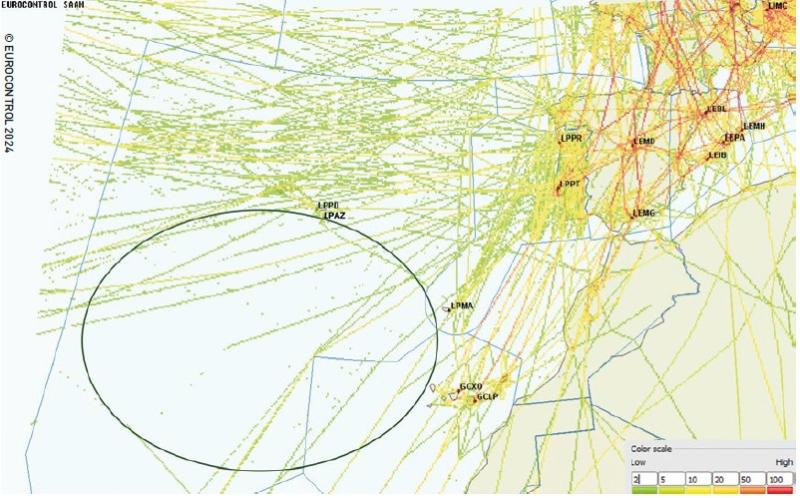 Real-time air traffic density snapshot over the Azores on 24 July 2024, one of the busiest days of the year. Prepared by the EUROCONTROL Airspace Management Team.
Real-time air traffic density snapshot over the Azores on 24 July 2024, one of the busiest days of the year. Prepared by the EUROCONTROL Airspace Management Team.
“It was crucial for us to demonstrate that the operational competency to launch and recover rockets exists in Portugal,” says Bruno Carvalho, Director of the Atlantic Spaceport Consortium. “Our vision is to continue fine-tuning procedures as we build up the capacity for larger orbital rockets.”
That vision involves not just bigger rockets but also a unique approach to spaceport operations designed ultimately to offer open access to commercial ventures across Europe and beyond. The primary goal is to facilitate the continued development of national and international partnerships, paving the way to a fully operational, commercially focused launch site.
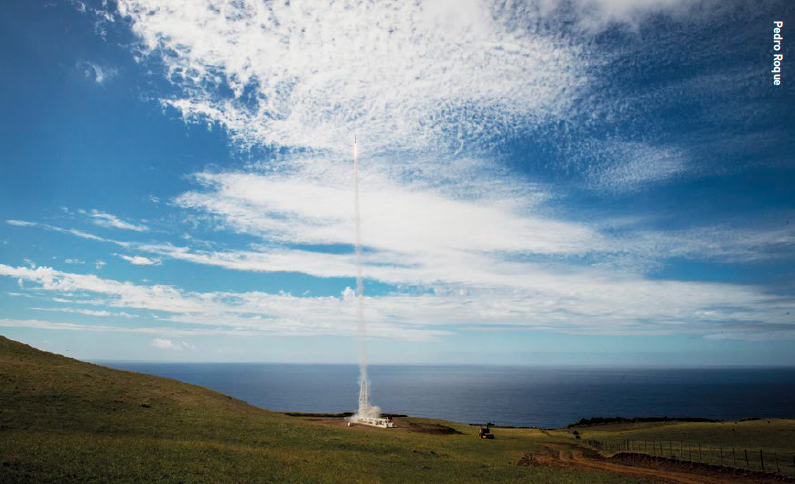 GAMA-2 launches into clear skies.
GAMA-2 launches into clear skies.
Stepping-stone to the stars
As a private initiative, it sends a clear message about Portugal’s emerging capability within the evolving global NewSpace industry
Portugal is no stranger to the space sector. A member of the European Space Agency (ESA) for more than 20 years, it hosts one of ESA’s ESTRACK antennas on Santa Maria Island in the Azores archipelago. Yet, its national space agency, Portugal Space, was established only in 2019. In just a few years, the agency has made bold strides, propelled by the government’s Space 2030 programme - a far-reaching strategy for economic growth that leverages everything from satellite data services to in-orbit manufacturing initiatives.
The Azores, located some 1400 km west of Portugal’s capital Lisbon, is an autonomous region of the country boasting nine volcanic islands, of which Santa Maria is one. The potential for a dedicated launch site there has been on the horizon for some time and Portugal Space has openly stated that Europe’s traditional big launchers (like Ariane or Vega from French Guiana) are well served but perceives a gap in medium launchers and the infrastructure to support them.
“It is evident that we need spaceports that can handle the requirements of new, medium lift launch vehicles,” Hugo Costa, a member of the Board of Directors at the Portuguese Space Agency, remarked at the 13th European Space Conference. “If we increase the number of spaceports available to Europe, it will again improve European independent access to space.”
In 2023, the Portuguese Space Agency estimated that the turnover of its national space ecosystem would be around €150 million.
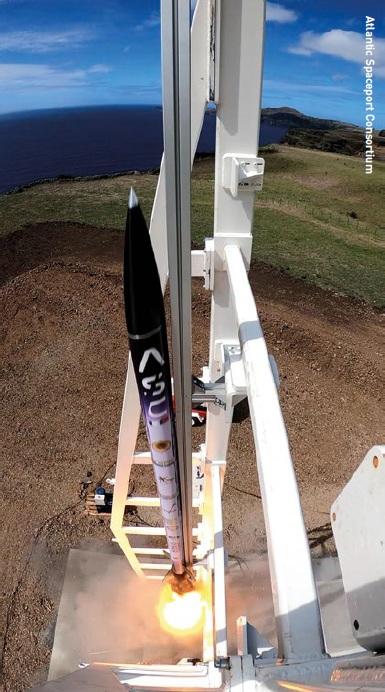 The moment of ignition for GAMA-2 test flight.
The moment of ignition for GAMA-2 test flight.
Regulatory framework
Much hinges on a quickly evolving Portuguese legal framework for space activities. Early in 2024, the country passed new space legislation laying the foundations for licensing and regulating launch activities, spaceport operations and associated safety protocols.
While Portugal Space supports policy and development, the final regulatory green light comes from the government through the country’s National Space Authority (ANACOM). Under the current Portuguese model, two forms of licensing are required: one for the physical spaceport infrastructure, and a second for each specific vehicle and mission profile, with ANACOM responsible for granting both.
“The final piece of the regulatory framework was published in late October,” says Bruno Carvalho, “which opened the door to a full licensing regime and means we can move forward with more permanent infrastructure.”
For now, the Atlantic Spaceport Consortium is operating with temporary measures that allow suborbital demonstrations, as showcased with the launch of its GAMA rockets, an approach which fits neatly into the European Union’s broader emphasis on deregulation and commercial partnerships for driving innovation in space.
“We’re building a truly open spaceport,” Carvalho enthused during an interview on a noisy Portugal Space stand at the International Astronautical Congress (IAC) in Milan, Italy, in October.
“Our recent suborbital launches from the Azores are more than just symbolic. We’ve proved that we can bring all the necessary logistics to Santa Maria Island for a smooth launch campaign. Yes, these are small rockets, but they serve as a demonstration of our operational competence - coordinating with civil aviation, maritime authorities and local government for safety and regulatory compliance.”
For a country that only recently established its space agency, the progress has been swift
Carvalho says the ASC has no intention to build or operate its own rockets commercially. “Our aim is to become a hub, or what we call an ‘open spaceport’ that welcomes multiple launch providers. There are more than 100 different launcher programmes worldwide and many are seeking suitable spaceport locations. We’re not going to pick winners or losers because we want to position Santa Maria as a flexible, open gateway.”
The intention is to establish multiple pads to avoid potential bottlenecks and ASC is currently working closely with Portuguese authorities to ensure it will be possible to handle various propellant types within local environmental and safety regulations.
Location, location
When it comes to launch services, Carvalho was keen to point out that location is everything. “Santa Maria sits at about 36 degrees latitude, a sweet spot for launching into polar, Sun-synchronous, and lower-inclination orbits,” he stated.
“It’s also in a region of the Atlantic that’s not crowded with major shipping or flight lanes. We control a large Flight Information Region (FIR) via a single authority, NAV Portugal, meaning we only need to coordinate with one air traffic agency to close airspace during launches. That’s a major advantage compared to having to negotiate with several FIRs across multiple jurisdictions.”
A formal licence application was made on 20 December as the next step to the spaceport becoming fully operational so the 90-day review period would conclude at the end of March unless additional clarifications are required,” explained Carvalho.
“Realistically, the summer of this year is the earliest we hope to start more permanent construction for suborbital services. For orbital launches, we’re looking at a longer timeframe - once we have the right infrastructure, safety reviews and the flight-ready vehicles from our clients.”
Medium-launch capacity gap
Europe has historically relied on the Kourou spaceport in French Guiana, South America, for its heavy-lift Ariane rockets and medium-to-light Vega rockets. While that facility remains indispensable, the rapidly changing commercial space landscape points towards a more distributed network of spaceports.
In the broader European context, new launch sites are springing up or are in advanced planning in places like Scotland (SaxaVord in the Shetlands and Sutherland on the mainland), Spaceport Cornwall (for horizontal launches) and Norway’s Andøya. These new spaceports are designed primarily around small and sometimes medium-lift vehicles but many of them face geographical challenges - long distances to open ocean, multiple FIRs to navigate, or potentially severe weather constraints. Against this backdrop, the Azores stands out for its mid-Atlantic positioning.
Hugo Costa reiterates that if Western Europe can add additional launch capability it strengthens the region’s independent access to space. “The Santa Maria Space Hub would be an important piece in that puzzle - particularly for medium-class launchers that need dedicated pads, simpler safety corridors and flexible scheduling,” he says.
Economic boost
The initiative also speaks to the broader trend within Europe - the desire for more diversified, flexible and independent access to space
Another key factor driving the Azores project is the economic potential. “The Azores already have mechanisms in place - such as free-zone customs clearance - which could significantly lower overheads for international launch customers,” adds Carvalho. “Our aim is to become a logistical hub, not only for launching but also for integrating payloads and recovering objects returned from orbit.”
The project has already attracted international interest, especially from the private sector. At the IAC in Milan, multiple companies approached Carvalho to discuss the open spaceport concept. For many smaller or startup launch providers, building their own infrastructure is not feasible and an existing, flexible site with partial on-site manufacturing, readily available hotels, great food and a mild climate can significantly reduce costs and logistical complexities.
In addition, Portugal’s ties with Portuguese-speaking communities worldwide, especially Brazil and nations in Africa, could open avenues for alliances. “We’re not just focusing on the local market,” says Carvalho. “We’re looking at fostering new strategic partnerships in Asia and elsewhere. The Azores is an Atlantic stepping stone that can serve global markets.”
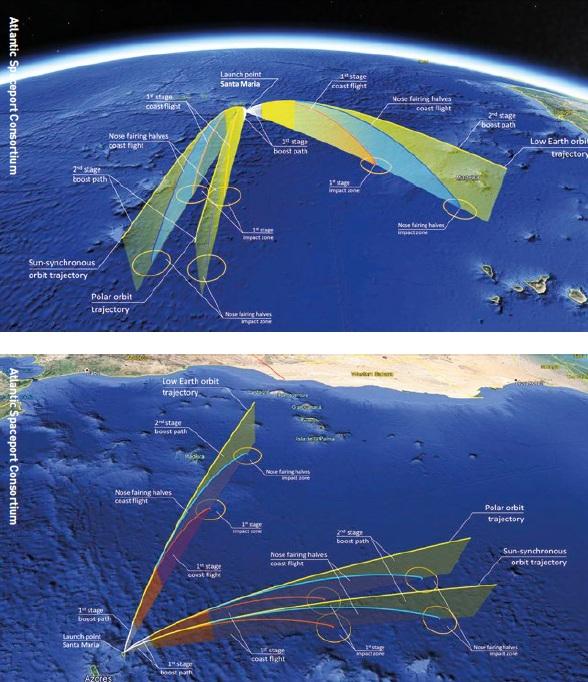 The ASC foresees three launch azimuths for sun-synchronous, polar and lower inclination orbits.
The ASC foresees three launch azimuths for sun-synchronous, polar and lower inclination orbits.
Environment and community
No modern spaceport can ignore environmental and community impact. Santa Maria has a small population and relies heavily on tourism and local industries, such as fishing. Carvalho acknowledges these constraints: “We’ve been very careful about ensuring minimal disruption. We don’t need to shut down the island’s main airport for a whole day - just for a few short windows. We’re engaging with the community to show that we can coexist with tourism and the local economy. Tourism itself might even benefit if we have scheduled launches - because ‘rocket tourism’ is a phenomenon in places like Florida and French Guiana.”
On the environmental side, the consortium is aware of how rocket propellants and debris can affect ecosystems. It plans to employ best practices as part of the regulatory approval process. “Portugal’s legislative framework is stringent about safety and environment,” Carvalho explains. “We see that as a feature, not a drawback, because it forces us to operate responsibly from day one. We’re also focusing on future green propellants and exploring how we can facilitate next-generation sustainable launch vehicles.”
Launch window
The Azores’ climate is famously unpredictable, with locals joking that if you don’t like the weather, wait 15 minutes. However, the island’s position within a subtropical latitude sees relatively mild temperatures year-round. Summers are temperate and winters, though prone to strong winds and waves in the surrounding ocean, still offer windows of calm for launch opportunities.
From a flight safety perspective, having only one Flight Information Region to manage is also a significant bonus. NAV Portugal oversees the airspace surrounding Santa Maria, ensuring a streamlined process for ground-based flight controllers to close airspace before launches. That minimises disruption to transatlantic flights, which typically already route much farther north or south, leaving the mid-Atlantic corridor comparatively free.
A second rocket and global vision
With the success of its first GAMA rocket launch, ASC immediately stated its aim to launch a second rocket the following day, reinforcing the message that repeatable, reliable launch operations are achievable from the Azores. “We wanted to show the world we can do this on a routine basis, not just a one-off test,” says Carvalho. “Our suborbital demonstrations form the bedrock for future orbital capabilities.”
Longer term, the vision doesn’t stop at a Santa Maria Space Hub. According to Carvalho, the consortium has also scouted locations in the Indian and Pacific Oceans and even further south in the Atlantic. These sites could, in theory, become part of a global network of spaceports that leverage Portugal’s budding regulatory know-how. Such an approach would potentially allow operators to pick the best location for their intended orbit, payload, or re-entry requirement.
International cooperation
The consortium has also scouted locations in the Indian and Pacific Oceans and even further south in the Atlantic
Portugal Space has been keen to emphasise cooperation between governments, private industry and academia. As an idea put forward by private industry, the Azores spaceport exemplifies this approach and despite some political setbacks and delays in securing legislation the momentum has continued, buoyed by Europe’s hunger for new launch sites.
Speaking to me during the Milan IAC, Hugo Costa echoed this sentiment. “Industry not government identified the Azores as a potential place for a spaceport. So it is important that industry can also develop roadmaps and make sure these policies are implemented,” he said.
As of spring 2025, the final regulatory green light is expected at any time, enabling the ASC to formalise its spaceport licence application. If all goes to plan, the consortium hopes to see a fully operational suborbital pad ready during the second half of 2025. Another year or so after that could see the first orbital-class rocket lighting its engines on Santa Maria.
 Pictured at the Azores launch site are Bruno Carvalho António Reis and Miguel Morgado (Spaceport Operations Manager).
Pictured at the Azores launch site are Bruno Carvalho António Reis and Miguel Morgado (Spaceport Operations Manager).
Atlantic launch hub
There are other elements to the long-term vision too. “Beyond launching satellites, we see potential for in-space manufacturing and re-entry services,” says Carvalho. “The Azores are perfectly situated for retrieval operations - there’s a vast stretch of open ocean around us, making it ideal for controlled splashdowns and recoveries. Ultimately, we aim to provide a seamless framework for that, including customs clearance, ground handling and logistic support on the island itself.”
The worldwide acceleration of NewSpace is pushing nations and private entities alike to revisit how, where and why rockets are launched. Portugal’s Azores Space Hub is a prime example, emerging as a serious contender in Europe’s competitive launch market, boasting a unique geographic advantage, a supportive legislative push, and an unwavering commitment from key stakeholders like the Atlantic Spaceport Consortium.
For a country that only recently established its space agency, the progress has been swift. From legislative breakthroughs to the first atmospheric rocket launch, the Azores initiative is both symbolic and practical. As Bruno Carvalho repeatedly underscored during our interview in Milan, it’s the practical demonstration of logistics, safety, local community support and regulatory backing all aligning in a mid-Atlantic location that is making the difference.
The initiative also speaks to the broader trend within Europe - the desire for more diversified, flexible and independent access to space. If the Azores can indeed offer an open spaceport model - an infrastructure platform ready to accommodate different commercial rockets and related services - then Portugal could soon be at the forefront of a burgeoning medium-lift launch market.
The Azores archipelago may not yet be a household name in the global space industry but it is well on the way to carving out its own niche. And in an era where space travel is no longer the sole domain of superpowers, the addition of Portugal’s mid-Atlantic outpost already stands as a testament to how smaller nations can be bold, creative and indispensable players in the 21st century space race.
Editor’s note
This article is based on interview at the International Astronautical Congress (IAC), in Milan, Italy, October 2024. With thanks to Bruno Carvalho of the Atlantic Spaceport Consortium, and Herminia Saraiva of the Portuguese Space Agency.





